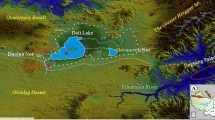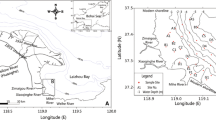Abstract
Annual grain-size variation was measured on the varved (annually laminated) lacustrine sediment from Cape Bounty East Lake using an innovative image analysis system. About 7100 images were acquired using a scanning electron microscope and processed to obtain measurement of particles from 2845 varves. Several particle-size distributions indices were calculated and can be linked to high-energy sedimentary facies. Moreover, the coarse grain size (98th percentile) of these high-energy facies is strongly correlated with summer rainfall (and also summer temperature) of instrumental data from nearby stations. Particle-size distributions show a similar trend through time, especially for the standard deviation and the 98th percentile. Climatic reconstruction suggests that Cape Bounty recently experienced an unprecedented increase of rainfall events since ~AD 1920. On the other hand, changes in varve thickness are weakly correlated with the particle-size distribution. Altogether, these results highlight the need to obtain annual grain-size data to identify a meteorological signal.










Similar content being viewed by others
References
Abdi H (2007) The Kendall rank correlation coefficient. In: Salkind NJ (ed) Encyclopedia of measurement and statistics. Sage, Thousand Oaks, pp 508–510
Box GEP, Cox DR (1964) An analysis of transformations. J R Stat Soc 26:211–252
Church M (1972) Baffin Island sandurs: a study of Arctic fluvial processes. Geological Survey of Canada, Department of Energy, Mines and Resources, Ottawa
Church M (1974) Hydrology and permafrost with reference to North America. In: Workshop seminar on permafrost hydrology, Environment Canada, pp 7–20
Church M (1988) Floods in cold climates. In: Baker VR, Kochel CR, Patton PC (eds) Flood geomorphology. Wiley, New York, p 528
Cockburn J, Lamoureux S (2008a) Inflow and lake controls on short-term mass accumulation and sedimentary particle size in a High Arctic lake: implications for interpreting varved lacustrine sedimentary records. J Paleolimnol 40(3):923–942
Cockburn JMH, Lamoureux SF (2008b) Hydroclimate controls over seasonal sediment yield in two adjacent High Arctic watersheds. Hydrol Process 22(12):2013–2027
Cogley JG, McCann S (1976) An exceptional storm and its effects in the Canadian High Arctic. Arct Alp Res 8:105–110
Cook RD, Weisberg S (1982) Residuals and influence in regression. Springer, New York, p 240
Cuven S, Francus P, Lamoureux SF (2010) Estimation of grain size variability with micro X-ray fluorescence in laminated lacustrine sediments, Cape Bounty, Canadian High Arctic. J Paleolimnol 44(3):803–817
Cuven S, Francus P, Lamoureux S (2011) Mid to Late Holocene hydroclimatic and geochemical records from the varved sediments of East Lake, Cape Bounty, Canadian High Arctic. Quat Sci Rev 30(19–20):2651–2665
De Keyser TL (1999) Digital scanning of thin sections and peels. J Sediment Res 69(4):962–964
Dugan HA, Lamoureux SF, Lafrenière MJ, Lewis T (2009) Hydrological and sediment yield response to summer rainfall in a small high Arctic watershed. Hydrol Process 23(10):1514–1526
Folk RL, Ward WC (1957) Brazos River bar: a study in the significance of grain size parameters. J Sediment Petrol 27(1):3–26
Francus P (1998) An image-analysis technique to measure grain-size variation in thin sections of soft clastic sediments. Sediment Geol 121(3–4):289–298
Francus P, Karabanov E (2000) A computer-assisted thin-section study of Lake Baikal sediments: a tool for understanding sedimentary processes and deciphering their climatic signal. Int J Earth Sci 89(2):260–267
Francus P, Nobert P (2007) An integrated computer system to acquire, process, measure and store images of laminated sediments. In: 4th International limnogeology congress, Barcelona, 11–14th July
Francus P, Prirard E (2004) Testing for sources of errors in quantitative image analysis. In: Francus P (ed) Image analysis, sediments and paleoenvironments. Kluwer Academic Publisher, Dordrecht, The Netherlands, pp 87–102
Francus P, Bradley RS, Abbott MB, Patridge W, Keimig F (2002) Paleoclimate studies of minerogenic sediments using annually resolved textural parameters. Geophys Res Lett 29(20):1998
Francus P, Bradley R, Lewis T, Abbott M, Retelle M, Stoner J (2008) Limnological and sedimentary processes at Sawtooth Lake, Canadian High Arctic, and their influence on varve formation. J Paleolimnol 40(3):963–985
Hodgson D (1989) Quaternary geology of the Queen Elizabeth Islands. In: Fulton RJ (ed) Quaternary geology of Canada and Greenland, vol 1. Geological Survey of Canada, Geology of Canada, pp 441–478
Hodgson D, Vincent JS, Fyles JG (1984) Quaternary geology of central Melville Island, northwest territories. Geological Survey of Canada Paper 83-16, Geology of Canada, p 23
Kaufman DS, Schneider DP, McKay NP, Ammann CM, Bradley RS, Briffa KR, Miller GH, Otto-Bliesner BL, Overpeck JT, Vinther BM (2009) Recent warming reverses long-term Arctic cooling. Science 325:1236–1239
Kaufman CA, Lamoureux SF, Kaufman DS (2011) Long-term river discharge and multidecadal climate variability inferred from varved sediments, southwest Alaska. Quat Res 76(1):1–9
Lamoureux S (2000) Five centuries of interannual sediment yield and rainfall-induced erosion in the Canadian High Arctic recorded in lacustrine varves. Water Resour Res 36(1):309–318
Lamoureux S (2002) Temporal patterns of suspended sediment yield following moderate to extreme hydrological events recorded in varved lacustrine sediments. Earth Surf Process Land 27:1107–1124
Lamoureux SF, McDonald DM, Cockburn JMH, Lafrenière MJ, Atkinson DM, Treitz P (2006) An incidence of multi-year sediment storage on channel snowpack in the Canadian High Arctic. Arctic 59:381–390
Laurin E (2010) The impact of experimental snow augmentation on soil thermal regimes and nutrient fluxes from High Arctic headwater catchments. Unpublished MSc. thesis, Queen’s University, Kingston, p 148
Lewis T, Braun C, Hardy DR, Francus P, Bradley RS (2005) An extreme sediment transfer event in a Canadian High Arctic stream. Arct Antarct Alp Res 37(4):477–482
Lewis T, Francus P, Bradley RS, Kanamaru K (2010) An automated system for the statistical analysis of sediment texture and structure at the micro scale. Comput Geosci 36:1374–1383
Lewis T, Lafrenière MJ, Lamoureux SF (2011) Hydrochemical and sedimentary responses of paired High Arctic watersheds to unusual climate and permafrost disturbance, Cape Bounty, Melville Island, Canada. Hydrol Process. doi:10.1002/hyp.8335
Lewkowicz AG, Wolfe PM (1994) Sediment transport in hot weather creek, Ellesmere Island, NWT, Canada, 1990–1991. Arct Alp Res 26:213–226
Lotter A, Sturm M, Teranes J, Wehrli B (1997) Varve formation since 1885 and high-resolution varve analyses in hypertrophic Baldeggersee (Switzerland). Aquat Sci Res Across Bound 59(4):304–325
Major JJ (2003) Debris flow. In: Middleton GV (ed) Encyclopedia of sediments and sedimentary rocks. Kluwer, Dordrecht, pp 186–188
Maronna RA, Martin RD, Yohai VJ (2006) Robust statistics. Wiley, Chichester
McDonald DM, Lamoureux SF (2009) Hydroclimatic and channel snowpack controls over suspended sediment and grain size transport in a High Arctic catchment. Earth Surf Process Land 34(3):424–436
Min SK, Zhang X, Zwiers F (2008) Human-induced Arctic moistening. Science 320:518–520
Moberg A, Sonechkin DM, Holmgren K, Datsenko NM, Karlén W (2005) Highly variable Northern Hemisphere temperatures reconstructed from low-and high-resolution proxy data. Nature 433(7026):613–617
Moritz RE, Bitz CM, Steig EJ (2002) Dynamics of recent climate change in the Arctic. Science 297:1497–1502
Nederbragt A, Thurow J (2004) Digital sediment colour analysis as a method to obtain high resolution climate proxy records. In: Francus P (ed) Image analysis, sediments and paleoenvironments. Kluwer Academic Publisher, Dordrecht, The Netherlands, pp 105–124
Nichols G (2009) Sedimentology and stratigraphy. Wiley-Blackwell, Chichester
Overpeck J, Hughen K, Hardy D, Bradley R, Case R, Douglas M, Finney B, Gajewski K, Jacoby G, Jennings A (1997) Arctic environmental change of the last four centuries. Science 278:1251–1256
Pautler BG, Simpson AJ, Mcnally DJ, Lamoureux SF, Simpson MJ (2010) Arctic permafrost active layer detachments stimulate microbial activity and degradation of soil organic matter. Environ Sci Technol 44(11):4076–4082
Reading HG (1996) Sedimentary environments: processes, facies and stratigraphy. Wiley-Blackwell, Malden
Rousseeuw PJ, Leroy AM (1987) Robust regression and outlier detection. Wiley Online Library, New York
Sheather SJ (2009) A modern approach to regression with R. Springer, New York
Shumway RH, Stoffer DS (2000) Time series analysis and its applications. Springer, New York
Soreghan MJ, Francus P (2004) Processing backscattered electron digital images of thin section. In: Francus P (ed) Image analysis, sediments and paleoenvironments. Kluwer Academic Publisher, Dordrecht, The Netherlands, pp 203–225
Stewart KA, Lamoureux SF (2011) Connections between river runoff and limnological conditions in adjacent high Arctic Lakes: Cape Bounty, Melville Island, Nunavut. Arctic 64(2):169–182
Acknowledgments
This work was supported by the Canadian Federal program for the international polar year (IPY) and by research grant of NSERC to Pierre Francus and Scott Lamoureux. Logistical support was provided by the Polar Continental Shelf Project, Natural Resources Canada (PCSP). Special thanks to David Fortin and Anna Pienkowski-Furze for core processing. Thanks to Arnaud De Coninck for help with the SEM and Laurence Provencher-Nolet for image analysis. The authors are grateful for the suggestions of Antti Ojala, the editorial comments of Darrell Kaufman and helpful input of two anonymous reviewers.
Author information
Authors and Affiliations
Corresponding author
Additional information
This is one of 18 papers published in a special issue edited by Darrell Kaufman, and dedicated to reconstructing Holocene climate and environmental change from Arctic lake sediments.
Electronic supplementary material
Below is the link to the electronic supplementary material.
Rights and permissions
About this article
Cite this article
Lapointe, F., Francus, P., Lamoureux, S.F. et al. 1750 years of large rainfall events inferred from particle size at East Lake, Cape Bounty, Melville Island, Canada. J Paleolimnol 48, 159–173 (2012). https://doi.org/10.1007/s10933-012-9611-8
Published:
Issue Date:
DOI: https://doi.org/10.1007/s10933-012-9611-8




